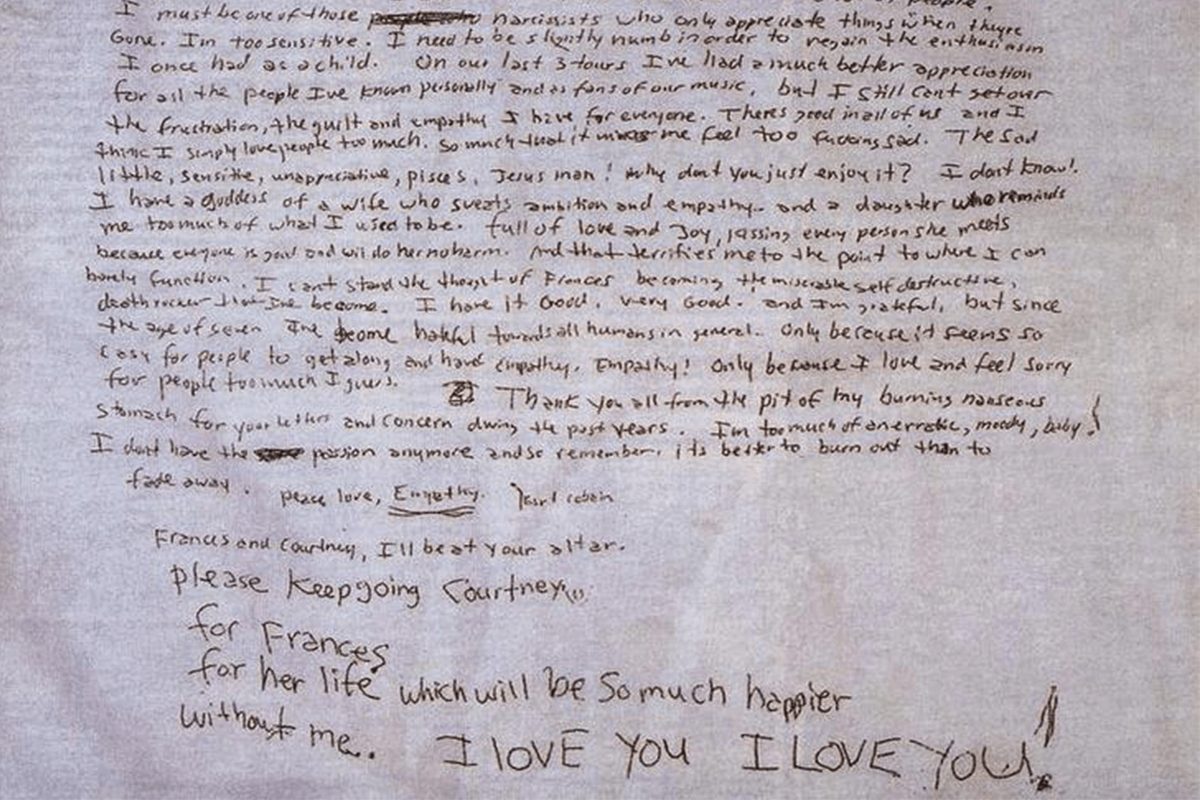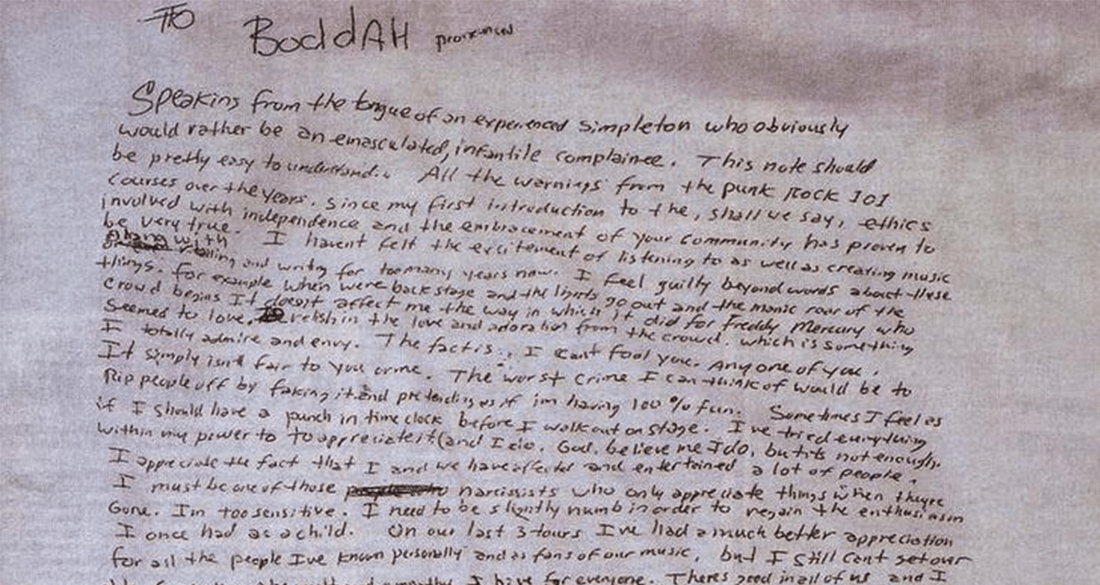Kurt Cobain's Suicide Note: Read It & Understand The Tragedy
Was the world robbed of a generational talent on April 5, 1994? The tragic and untimely death of Kurt Cobain, the iconic frontman of Nirvana, remains a deeply unsettling event that continues to ignite debate and spark endless speculation about the circumstances surrounding his demise.
The note, addressed to his imaginary childhood friend Boddah, revealed a glimpse into Cobain's inner turmoil. He spoke of his "burning, nauseous stomach," his feelings of being an "erratic, moody baby," and the loss of passion that fueled his creative fire. The final, heartbreaking lines "It's better to burn out than to fade away" have become synonymous with his life and legacy, a chilling testament to his struggles with fame, addiction, and the crushing weight of depression.
| Bio Data | Details |
|---|---|
| Full Name | Kurt Donald Cobain |
| Born | February 20, 1967, Aberdeen, Washington, USA |
| Died | April 5, 1994, Seattle, Washington, USA (declared on April 8, 1994) |
| Nationality | American |
| Occupation | Musician, Singer, Songwriter, Artist |
| Known For | Lead singer, guitarist, and primary songwriter of the band Nirvana |
| Spouse(s) | Courtney Love (m. 19921994) |
| Children | Frances Bean Cobain |
| Associated acts | Nirvana, Fecal Matter |
| Genre(s) | Grunge, Alternative Rock |
| Instruments | Vocals, Guitar, Drums |
| Years Active | 1985-1994 |
| Official Website (Reference) | Nirvana Official Website |
The discovery of Cobain's body in his Seattle home on April 8, 1994, marked the end of an era and the beginning of an enduring mystery. The official cause of death was ruled a suicide by gunshot wound, but the circumstances surrounding his death have been the subject of intense scrutiny and speculation for decades. The final words, a suicide note, were found near his body, a heartbreaking letter addressed to his wife, Courtney Love, and their daughter, Frances Bean Cobain. In the note, Cobain expressed his feelings of being overwhelmed by fame and struggling with the pressures of the music industry and personal demons.
The content of the note itself is a raw and vulnerable expression of a man consumed by inner turmoil. The tone shifts from moments of gratitude to expressions of profound sadness and despair. He wrote about his feelings of guilt, frustration, and sensitivity, revealing a struggle with fame, drug addiction, and crippling depression. The influence of his difficult childhood, marked by his parents' separation and subsequent emotional challenges, is evident in his writings, adding another layer to the complexity of his character.
Cobain's note also included a poignant farewell to his family, particularly to his wife, Courtney, and their young daughter, Frances Bean. The note's emotional weight is undeniable, and it continues to move readers. In this last letter, Cobain acknowledged his emotional pain and stated his decision to end his life. The tragic circumstances surrounding Cobain's death, combined with the contents of the suicide note, have continued to fuel the publics obsession and fascination with the singer.
The investigation into Cobain's death has been fraught with controversies and discrepancies, leading to numerous theories and accusations. One of the most prominent theories, popularized by filmmaker Ian Halperin and investigative journalist Max Wallace, suggests foul play, specifically pointing to Courtney Love. The lack of concrete evidence, combined with inconsistencies in the police reports and the medical examiners findings, has kept the case alive in the public's mind. A week after Cobain's death, a series of claims suggesting discrepancies in the police reports, including alterations in the nature of the shotgun blast, were made. Tom Grant, a private investigator hired by Courtney Love after Cobain disappeared, has long maintained that the death was not a suicide, and that the official narrative does not provide all the answers.
Another point of contention revolves around the levels of heroin found in Cobain's system. Some believe the amount was so high that it would have been impossible for him to pull the trigger, suggesting that someone else administered the drug. However, the toxicology reports have been subject to various interpretations, with some experts suggesting the levels were within the realm of a potential overdose but not necessarily immediately fatal.
The release of the posthumous "Journals" offers a deeper glimpse into Cobains inner world. The compilation of letters, early drafts, and sketches reveals his creative process and his personal struggles. It also shows the influence of various artists and thinkers, including John Lennon, The Stooges, and David Bowie, all of whom played a role in shaping his artistic vision. His writing provides a stark contrast to the public image of a rock star and reveals a sensitive individual who battled his demons in private, while still trying to stay in touch with his creative passion.
Cobains struggles with drug addiction and his experiences in rehab also add depth to the narrative. In a letter written in 1992, he candidly described his attempts to deal with his pain through "small doses of heroine," further illustrating the depths of his addiction and his attempts to find relief. Cobain's battles with substance abuse were well-documented. These battles, coupled with the pressures of fame and his deteriorating mental health, all contributed to the tragedy.
The legacy of Kurt Cobain extends beyond his musical contributions. He became an icon for an entire generation, a symbol of the grunge movement, and a voice for those who felt marginalized or misunderstood. His music, characterized by raw emotion, honesty, and vulnerability, resonated with millions of people worldwide. His untimely death cemented his place in the 27 Club, a tragic group of musicians who died at the age of 27, adding to the mythos that surrounds his life and career.
The questions surrounding Cobain's death remain unresolved. The autopsy report itself has been a source of debate, with some claiming that it does not fully support the staged suicide theory. The lack of definitive answers continues to fuel the public's fascination with the case and the ongoing efforts to uncover the truth. The quest to understand what happened to Kurt Cobain is a testament to the impact he had on the world and the lasting questions that his life and death have left behind. The mystery that continues to surround Cobains final hours is a dark shadow that will forever linger over his legacy. The absence of conclusive answers leaves a void, an invitation for theories, and a deep longing to understand the forces that drove such a brilliant and sensitive artist to his tragic end. The enduring fascination with his life and death is a clear sign of the impact he had on music and culture.


